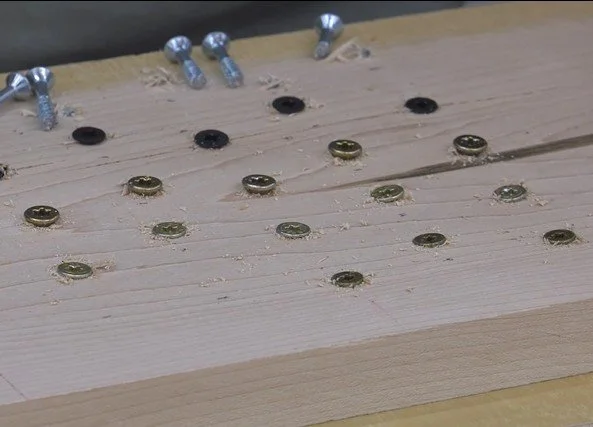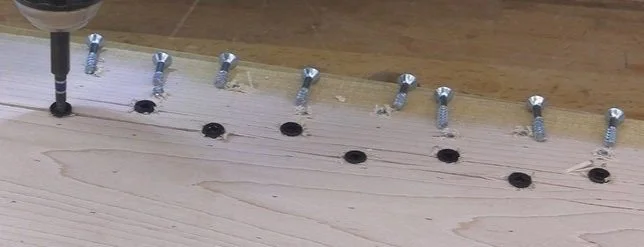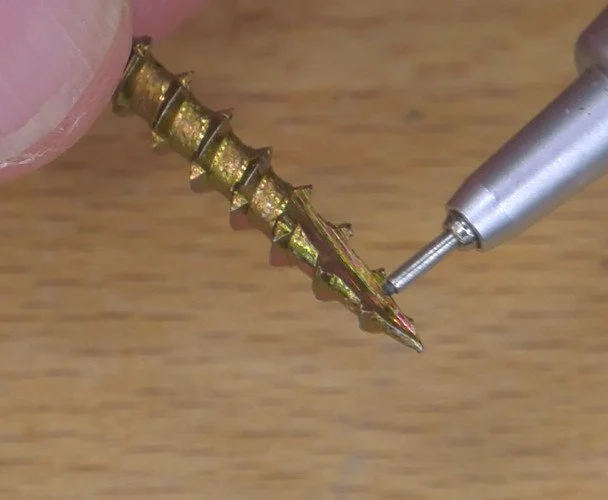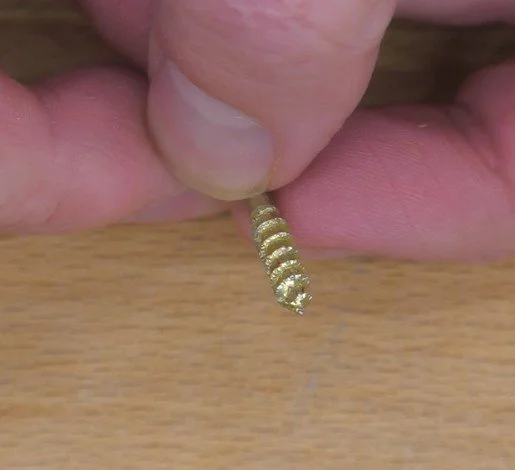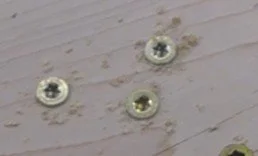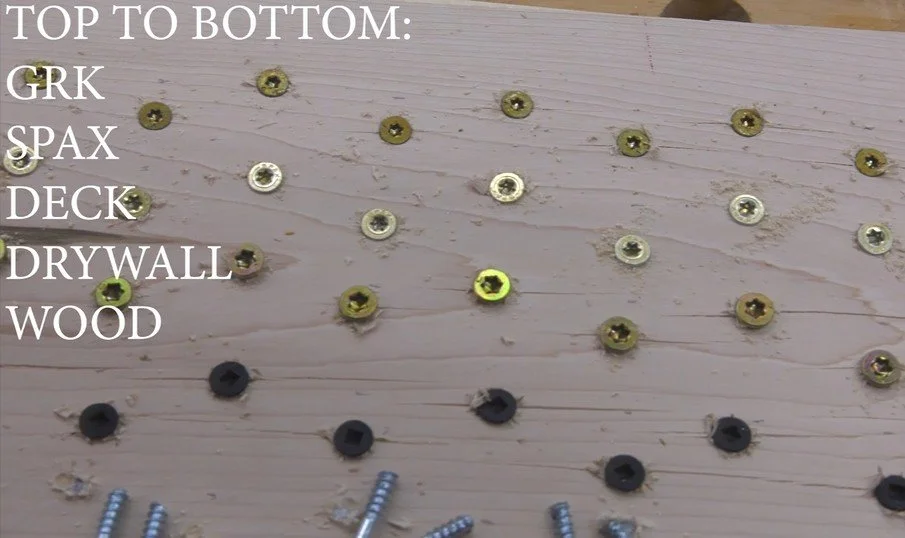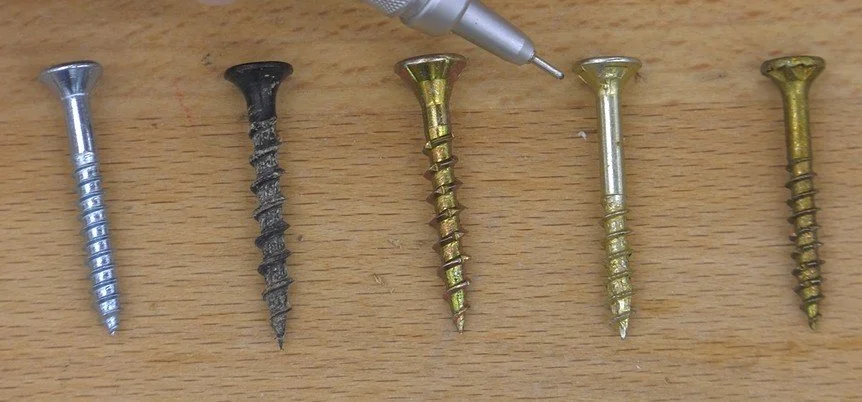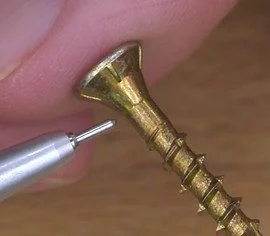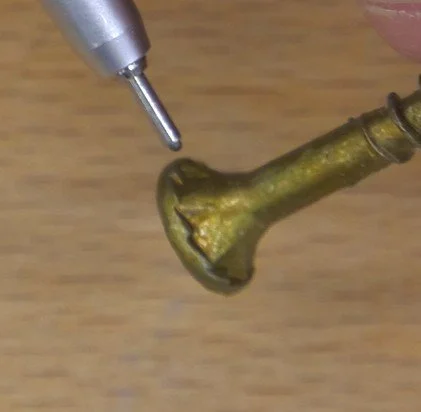HOW SIMPLE WOOD SCREWS ARE NO LONGER THE SAME
A couple of years ago, I was taking apart some old benches I no longer had a use for. It occurred to me that they had held up for a long time despite being held together with drywall screws. In fact, I’ve built a lot of shop-related projects with drywall screws over the years, the most striking example being the lofts in my old workshop. The main beams, the joist hangers, even the ceiling ties, all relied entirely on the strength of drywall screws to support an obscene amount of weight once I loaded them up with hardwood and other materials. They remained solid for years without so much as a creak.
A loft from my old workshop built with drywall screws.
Of course, just because my stuff didn’t come crashing down doesn’t mean it’s safe to use drywall screws in structural applications. You absolutely should not do that. But I have no problem using them to build benches, and I’ve even hidden a drywall screw or two in strategic places in furniture and cabinetry projects, as I’m sure you have too.
So, the question is: Are the higher-priced construction screws such as GRK and Spax worth the cost if you aren’t building something structural, such as framing a house or a deck? Do the fancy features of these screws—such as fluted points, serrated teeth, and complex head geometry—make any difference at all for most day-to-day projects?
I did some testing and learned some unexpected things that completely changed how I use screws. Seriously, after reading this, you’ll never look at a screw the same way again.
Drywall Screws
Driving drywall screws into hard maple
In this example I’m driving a bunch of drywall screws into hard maple. Granted, this test isn’t entirely fair to the drywall screw, because I’d never drive screws into hardwood without a pilot hole. And as expected, I got a lot of splitting along the grain.
Coated Deck Screws
The fluted tip of a coated deck screw.
Then I did the same thing with coated deck screws, which have an added feature: a fluted tip designed to bore its own pilot hole, of sorts. These screws didn’t split the maple as much, but while the tip cuts through the wood fibers, it doesn’t seem to excavate the tiny chips from the hole. As a result, the effect was minimal.
Spax Screws
Serrated threads of a Spax screw.
Wood chips surrounding the Spax screws.
But the Spax screws have no fluted points. Instead, they feature uniquely serrated threads. These seem to chew up the wood fibers and more effectively auger them up and out of the hole, providing clearance for the screw shaft and all but eliminating splitting, even in very hard wood. You can actually see more tiny wood chips around the Spax screw heads. It’s a very clever design that made a big difference. Score one for their patented serrated threads.
GRK Screws
GRK screws have a fluted tip and notched threads.
That doesn’t mean there’s no value in a fluted tip, though. The GRK screws have a fluted tip, but rather than fully serrated threads because those are patented, they feature a few notches stamped here and there. This seems like a hybrid between the fluted deck screw and the serrated Spax screws. The tip severs the fibers ahead of the screw, and the notched threads help excavate the chips. The results weren’t as good as the serrated threads, but certainly better than fluted tips alone.
Head Geometry and Performance
As you look at the different types of screws I tested, you might notice the heads are set at different levels. This was not intentional. I used the same clutch setting for them all, driving them with the same force. I didn’t stop any of the screws before the drill clutch engaged. This brought to light some of the differences between the various head designs.
The bugle shaped head of a drywall screw.
A drywall screw features a bugle-shaped head designed to compress the paper on a sheet of drywall without tearing it. The rest of the screws have conical-shaped heads that are better suited for compressing wood fibers with a radial wedging action—or even cutting those fibers, depending on the head's texture.
The other screw types have conical-shaped heads.
It’s the drywall screw’s flatter profile that makes it appear more deeply embedded in the surface of the maple than, say, the deck screw. But in reality, that bugle-shaped head is its weakness. When I turned off the drill’s clutch and tried to force the drywall screw heads into the surface of the wood, that flatter profile resisted. Some heads snapped off, while others stayed only on the surface until the threads stripped out the fibers within the hole and lost their grip.
The coated deck screws, on the other hand, feature a large, double-bevel beneath the head. This is designed to ease it into the wood, with the steeper portion beginning to spread and compress the fibers, followed by the shallower bevel, which fits a common 45-degree countersink.
The coated deck screws, on the other hand, feature a large, double-bevel beneath the head.
There are also slight ridges around the head of the deck screw to help sever some of the fibers. These differences in head design enabled it to embed below the surface of the white oak without a pre-bored countersink. I drove them as deeply as I could before the threads stripped out the hole, and in one case, a head snapped off.
The Spax screws and the GRK screws feature single-beveled heads. These may not spread the fibers as efficiently as the deck screw’s dual bevels, but they displace less wood overall. And they also feature more fiber-shredding ribs, with the GRK version being by far the most aggressive. That made a difference.
GRK screws feature more aggressive fiber-shredding ribs.
Unlike the GRK screws, the Spax screws struggled a bit to embed themselves in the hardwood. None broke, but all of them stripped out their holes and lost their gripping power before the heads were fully below the surface.
From Left to Right: Regular Wood Screw, Drywall Screw, Deck Screw, Spax Screws, GRK Screws
Another factor in that poor performance may be that less than half of the Spax shaft is threaded, compared to two-thirds of the GRK and three-quarters of the deck screw. The bare portion of the shaft is designed to help pull two boards together, but fewer threads can also mean less gripping power.
As expected, the GRK screws did embed themselves more fully. In fact, I was able to sink them below the surface without stripping out their holes at all—something none of the other screws could do.
This was surprising because the deck screws have slightly coarser threads, and more of them. You would expect these to produce more holding force within the hole. And they might if you’re careful not to over-drive them. However, it seems to be the deck screw’s larger head—not necessarily the threads—that stopped it from going deeper. On the other hand, the more aggressive cutting design of the GRK head works along with its threads to bore into the wood without stripping the hole.
Conclusion: Is It Worth Upgrading?
This is an important point: Any of these screws in this test will hold a massive amount of weight by virtue of the threads alone. But when it comes to true holding power, you need to consider the other factors we’ve discussed. The more a screw splits the wood fibers around the hole, the less it can grip the wood. The easier it strips out the fibers within the hole—something directly related to head geometry—the more likely the screw will pull out of that hole later.
That’s why I ran these particular tests the way I did. I think they brought out the subtle (and sometimes not-so-subtle) differences between modern screw features, highlighting how some things you may not have considered can significantly affect a screw’s performance.
To summarize: Drywall screws are strong enough in and of themselves for non-structural projects. But they lack some important features that could otherwise make the joints stronger.
For example, fluted tips and serrated threads help reduce fiber separation around the hole, which may weaken a screw's grip where no pilot hole has been pre-bored. The Spax screws especially excelled at this.
I also think the more aggressive the cutting geometry under the screw head, the better—even if you use a countersink bit. This is because you may still slightly overdrive your screw, and if the head can’t effectively sever more of the fibers, you may unknowingly partially strip the hole and weaken the joint. The GRK screws had the best head design.
But perhaps the most important lesson is the benefits of using a pilot bit with a countersink and a driver with a clutch feature. These can cancel out many of these subtle differences and improve the grip of even drywall screws.
★SOME OF MY FAVORITE INEXPENSIVE TOOLS★
-ISOtunes Hearing Protection (Save 10%): https://bit.ly/3BHYdH7
-BOW Featherboards: https://amzn.to/430ldhv
-123 Blocks: https://lddy.no/vpij
-Mechanical Pencils: https://amzn.to/2PA7bwK
-Lumber pencil: https://amzn.to/2QtwZjv
-Pocket Measuring Tape: http://amzn.to/2kNTlI9
-Nut/Bolt/Screw Gauge: http://amzn.to/2CuvxSK
-Self-Centering Bits: https://amzn.to/2xs71UW
-Steel Ruler: https://lddy.no/10mv7
-Center-Finding Ruler: https://lddy.no/10nak
-Bit & Blade Cleaner: https://amzn.to/2TfvEOI
-Narex Chisels: https://lddy.no/sqm3
-Mini Pull Saw: https://amzn.to/2UEHBz6
-Shinwa Rulers: https://lddy.no/zl13
(If you use one of the affiliate links above, we may receive a small commission)


